Complete Solutions to EXAMPLES of chapter SOUND of Class 10 book with complete answers and questions
| Class 10 | PHYSICS |
| Chapter | SOUND |
| SELINA PUBLICATION | EXAMPLES |
| Number Of Questions | 35 |
| Academic Year | 2023-24 |
The human ear can detect continuous sounds in the frequency range from 20 Hz to 20,000 Hz, Assuming that the speed of sound in air is `330 ms^(-1)` for all frequencies, calculate the wavelengths corresponding to the given extreme frequencies of the audible range.
View SolutionThe diagram below shows (a) displacement-time, and (b) displacement-distance, graph of a wave travelling in a string with velocity 20 m `s^(-1)`. In each case, use the graph to calculate the frequency and wavelength of the wave.

View SolutionA sound produced on the surface of a lake takes 4-5 s to reach a boatman. How much time will it take to reach a diver inside water at the same distance if speed of sound in water is 4.5 times the speed of sound in air ?
View SolutionA boy hears an echo of his own voice from a distant hill after one second. The speed of sound in air is 350 m `s^(-1)`. What is the distance of the hill from the boy?
View SolutionA “RADAR' is able to detect the reflected waves from an enemy's aeroplane after a time interval of 0:02 milli-second. If the velocity of the waves is `3 xx 10^8 m s^(-1)`, calculate the distance of the aeroplane from the radar.
View SolutionA boy standing in front of a wall at a distance of 85 m produces 2 claps per second. He notices that the sound of his clapping coincides with the echo. The echo is heard only once when clapping is stopped. Calculate the speed of sound.
View SolutionA boy stands 60 m in front of a tall wall and claps. The boy continues to clap every time an echo is heard. Another boy finds that the time taken between the first and fifty-first clap is 18 s. Calculate the speed of sound.
View SolutionA man standing in front of a vertical cliff fires a gun. He hears the echo after 3 s. On moving closer to the cliff by 82-5 m, he fires again and hears the echo after 2.5 s. Find :
the distance of the cliff from the initial position of the man,
View SolutionA man standing in front of a vertical cliff fires a gun. He hears the echo after 3 s. On moving closer to the cliff by 82.5 m, he fires again and hears the echo after 2.5 s. Find :
the speed of sound.
View SolutionA person standing between two vertical cliffs and 640 m away from the nearest cliff, produces sound. He hears the first echo after 4 s and the second echo 3 s later. Calculate :
the speed of sound in air,
View SolutionA person standing between two vertical cliffs and 640 m away from the nearest cliff, produces sound. He hears the first echo after 4 s and the second echo 3 s later. Calculate :
the distance between the cliffs
View SolutionIn a SONAR, ultrasonic waves are sent into the sea water and the reflected waves from a sunken ship are received after 2.0 s. If the velocity of waves in sea water is 1450 m `s^(-1)` , find the depth of the sunken ship.
View SolutionFig. shows three different modes of vibration of a string of length I.
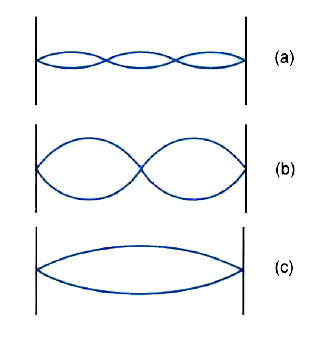
Which vibration is of the largest amplitude ?
View SolutionFig. shows three different modes of vibration of a string of length I.
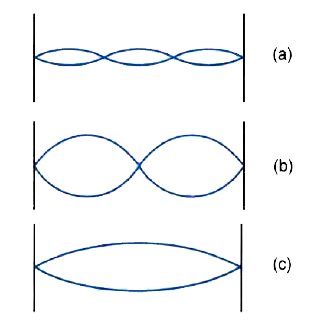
Which vibration is of the least frequency?
View SolutionFig. shows three different modes of vibration of a string of length I.
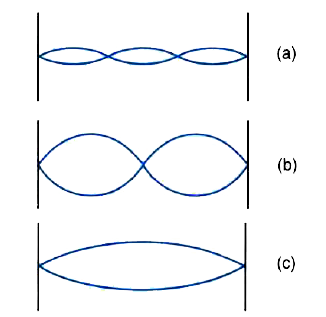
What is the ratio of frequency between (a) and (c)?
View SolutionFig. shows three different modes of vibration of a string of length I.
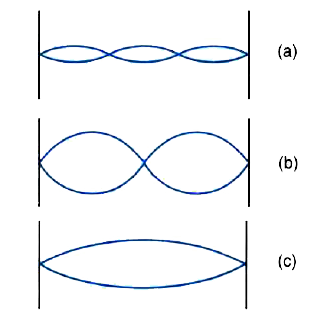
What is the ratio of wavelength between (b) and (a)?
View SolutionA wire of length 80 cm has a frequency of 256 Hz. Calculate the length of a similar wire under similar tension, which will have frequency of 1024 Hz.
View SolutionThe stem of a vibrating tuning fork is pressed against a table top.
Will it produce an audible sound ?
View SolutionThe stem of a vibrating tuning fork is pressed against a table top.
Does it cause the table top to set in vibrations ? If yes, what type of vibrations are they?
View SolutionThe stem of a vibrating tuning fork is pressed against a table top.
Under what condition does it lead to resonance ?
View SolutionA wire is stretched between two bridges A and B. A small piece of paper of shape A (called rider) is placed at the middle of the wire. When the stem of a tuning fork P is placed at the bridge A the rider only vibrates, but it flies away when another tuning fork Q is placed. Explain the difference.
View SolutionA vibrating tuning fork is placed over the mouth of a burette filled with water. The tap is opened and the water level gradually falls.
What do you observe ? Name the phenomenon. When does it happen?
View SolutionA vibrating tuning fork is placed over the mouth of a burette filled with water. The tap is opened and the water level gradually falls.
What do you observe ? Name the phenomenon. When does it happen?
View SolutionThe natural frequency of an air column in a pipe fixed at one end, of length 17 cm is 500 Hz. At what length of air column, a tuning fork of frequency 250 Hz will resonate with it?
View SolutionSometimes when a vehicle is driven at a particular speed, a rattling sound is heard. Explain briefly, why does this happen and give the name of the phenomenon taking place. Suggest one way by which the rattling sound could be stopped.
View SolutionA string vibrates with a natural frequency of 256 Hz. Which of the tuning fork given below will resonate with the string ? (i) A of frequency 512 Hz, (ii) B of frequency 256 Hz, and (iii) C of frequency 128 Hz. Give reason.
View SolutionIn Fig. , A and B represent the displacement distance graphs for two sound waves when they pass through air.

What is the relation between their
velocities
View SolutionIn Fig. , A and B represent the displacement distance graphs for two sound waves when they pass through air.
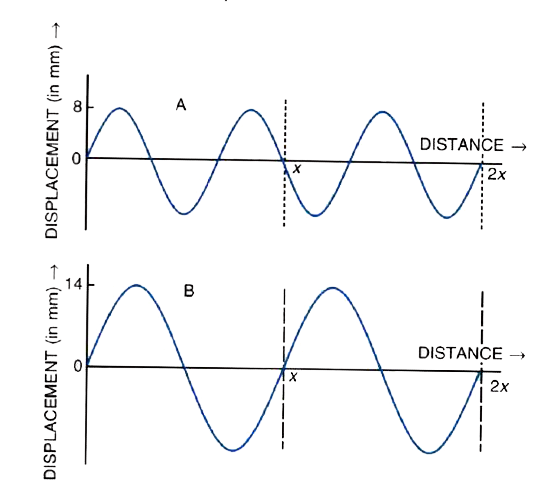
What is the relation between their
wavelengths
View SolutionIn Fig. , A and B represent the displacement distance graphs for two sound waves when they pass through air.
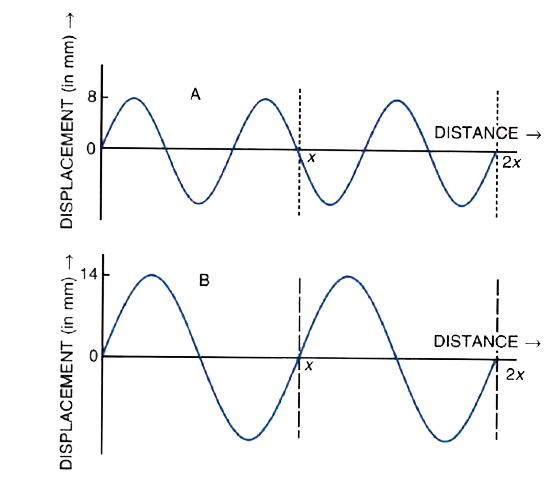
What is the relation between their
pitch
View SolutionIn Fig. , A and B represent the displacement distance graphs for two sound waves when they pass through air.

What is the relation between their
loudness
View SolutionIn Fig. , A and B represent the displacement distance graphs for two sound waves when they pass through air.
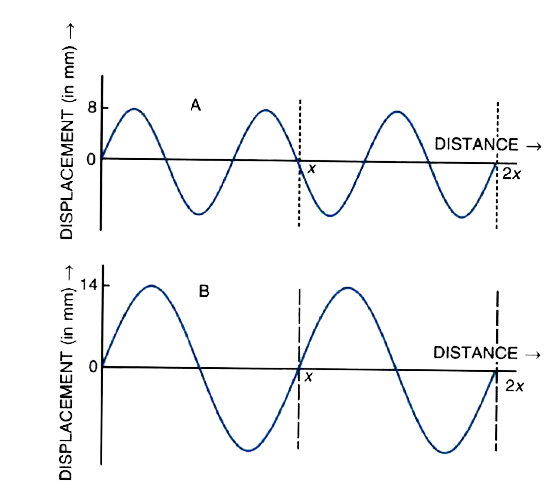
How do they differ in quality ?
View SolutionA certain sound has a frequency of 256 hertz and a wavelength of 1.3 m.
(a) Calculate the speed with which this sound travels.
(b)What difference would be felt by a listener between the above sound and another sound travelling at the same speed, but of wavelength 2.6 m?
View SolutionA certain sound has a frequency of 256 hertz and a wavelength of 1.3 m.
(a) Calculate the speed with which this sound travels.
(b)What difference would be felt by a listener between the above sound and another sound travelling at the same speed, but of wavelength 2.6 m?
View SolutionThe ratio of amplitudes of two waves is 3 : 4. Find the ratio of their
loudness
View SolutionThe ratio of amplitudes of two waves is 3 : 4. Find the ratio of their
pitch
View Solution
EXAMPLES questions and complete solutions for chapter SOUND of SELINA PHYSICS (ENGLISH) of Class 10